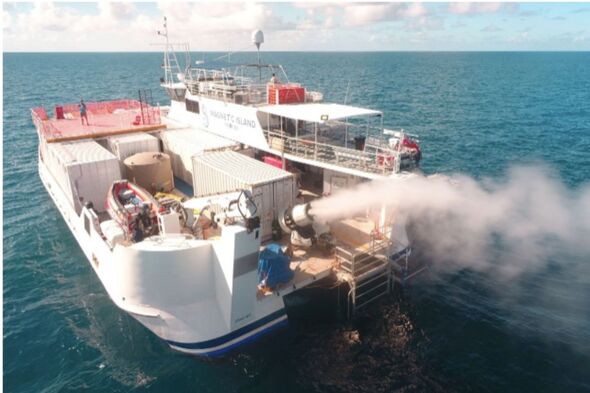UPDATE: A controversial geoengineering experiment aimed at altering weather patterns above the San Francisco Bay was abruptly halted by city officials after just 20 minutes of operation. The initiative, backed by a group of billionaire donors, raised significant concerns about transparency and regulatory compliance, according to new documents obtained by Politico’s E&E News.
The project, led by the University of Washington, aimed to use a retired aircraft carrier to deploy salt water-spraying machinery over a stretch of ocean larger than Puerto Rico. This multi-million dollar endeavor sought to create artificial clouds to reflect sunlight and combat global warming. Initially planned as a monthslong effort, the experiment intended to expand to other regions, including parts of western North America, Chile, and south-central Africa.
According to the leaked documents, the Marine Cloud Brightening Program (MCB) was designed to assess the feasibility of cloud-manufacturing technologies that could produce detectable changes from space. However, city officials in Alameda intervened, stating they were not informed of the experiment prior to its commencement.
“At such scales, meaningful changes in clouds will be readily detectable from space,” noted a 2023 research plan from the MCB. Despite the initial setback, it remains unclear whether project leaders or their billionaire backers will continue pursuing similar initiatives.
CRITICAL BACKGROUND: Solar geoengineering, which includes techniques like spraying saltwater aerosols over the ocean, aims to mitigate climate change effects by reflecting sunlight. However, this practice has been met with fierce criticism and conspiracy theories regarding potential weather manipulation. Some U.S. lawmakers, including Rep. Marjorie Taylor Greene, have sought to ban these technologies outright, linking them to disastrous weather events.
In fact, more than 575 scientists have called for a total ban on geoengineering due to concerns it cannot be governed fairly or effectively on a global scale. Yet proponents argue that the urgent need to address climate change justifies ongoing research, with calls for safe testing in controlled environments.
“Scientists are facing political attacks and drastic funding cuts,” said Chris Larsen, a cryptocurrency billionaire and donor to the University of Washington program. “We need to complement a rapid energy transition with more research into a broad range of potential climate solutions.”
The costs associated with the aborted Alameda project were estimated to be between $10 million and $20 million, with significant uncertainties surrounding operational and funding challenges. The secretive nature of this research has hindered its chances of gaining government support for further geoengineering studies.
Despite the political and public backlash, some researchers remain steadfast in their belief that climate solutions must include innovative geoengineering strategies. “If we really were serious about the idea that to do any controversial topic needs some kind of large-scale consensus before we can research the topic, I think that means we don’t research topics,” stated David Keith, a professor at the University of Chicago.
As the situation evolves, the conversation around geoengineering and its implications for climate policy continues to gain traction. The Mirror has reached out to several key players for further comments, including project leaders and their billionaire supporters, as the public awaits clarity on the future of such initiatives.
WHAT TO WATCH FOR: As debates intensify over weather modification and climate intervention, the impact of this thwarted project may resonate across policy discussions and scientific communities. Stay tuned for updates on how this situation develops and its potential ramifications for future climate research.
